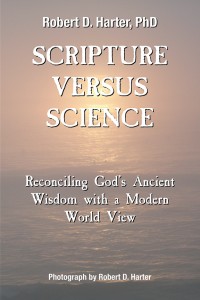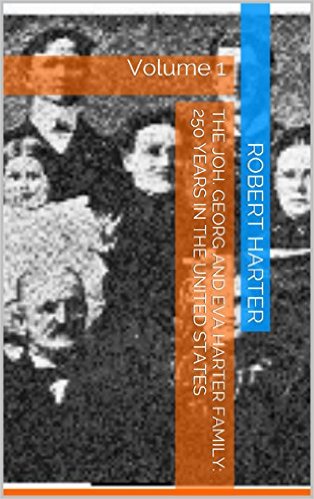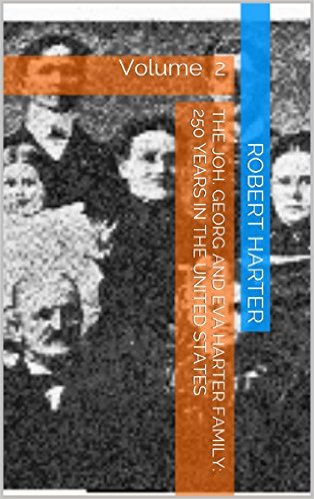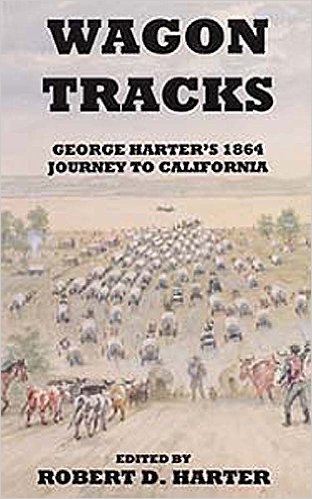About the Book
 With trepidation, Dr. Robert D. Harter approached the subject of Earth origins and human development from the position of a lifelong Christian who is also a scientist.
With trepidation, Dr. Robert D. Harter approached the subject of Earth origins and human development from the position of a lifelong Christian who is also a scientist.
He grew up in a rural Ohio Christian family and thoroughly understands the position of those who believe the Earth and everything in it was created a few thousand years ago. At the same time, he is a university professor who understands the basis upon which the Earth is claimed to be millions of years old.
Both positions cannot be correct, and it is probable that neither is completely wrong. Using a scientist’s analytical approach, Dr. Harter evaluated and compared biblical, anthropological, and geological records. In Scripture Versus Science, he proposes a resolution to the increasingly heated argument about evolution. While unlikely to provide a clear and definitive answer, this book begins to thin the “fog” that has developed around it.
He states, “There has been a lot of fog associated with whether God created the universe and everything in it, or whether it just happened by chance. In writing this book, I attempt to show that the ideas supporting the two views are not necessarily mutually exclusive. In other words, I hope I have allowed a bit of sun to shine through the fog.”
A Dream Achieved
 Do you have a dream? Don’t be discourages and give up on it. Failure is self fulfilling, and so is success. Achieving a dream may require sacrifices and may involve hard work along the path. At times the effort may not seem to be worth it, but the euphoria felt upon achieving your dream can make it all worthwhile.
Do you have a dream? Don’t be discourages and give up on it. Failure is self fulfilling, and so is success. Achieving a dream may require sacrifices and may involve hard work along the path. At times the effort may not seem to be worth it, but the euphoria felt upon achieving your dream can make it all worthwhile.
This book records the highs and lows one person felt as he went from near discouragement to fulfilling and exceeding his dream. There are many genetic and environmental forces which shape a person.
Growing up as son of a tenant farmer the author had many dreams of a life beyond the farm, but no real expectation of becoming something other than a farmer. He dreamed of a college education, but could see no way of ever being able to afford college. Then one day his life came to a fork in the road and he chose the path which led to achieving his dreams.
This book compiles the memories of that farm boy who ultimately realized those dreams of youth. The path taken led to becoming a professor at a State University. The shaping of that professor is chronicled in this autobiography.
The Joh. Georg and Eva Harter Family: 250 years in the United States: Volume 1
 Georg Harter is believed to have arrived in Philadelphia aboard the Phoenix in September 1749. He made his way to the area now a part of Lehigh County and there he found romance. He and Eva Bracker were married on October 2, 1752, in the St Paul’s Evangelical Lutheran Congregation. It is unknown when Eva’s family arrived in the United States. Two sons were born in Lehigh County, but then the family disappeared until showing up in the Frederick County, Maryland, Lutheran church records in 1769.
Georg Harter is believed to have arrived in Philadelphia aboard the Phoenix in September 1749. He made his way to the area now a part of Lehigh County and there he found romance. He and Eva Bracker were married on October 2, 1752, in the St Paul’s Evangelical Lutheran Congregation. It is unknown when Eva’s family arrived in the United States. Two sons were born in Lehigh County, but then the family disappeared until showing up in the Frederick County, Maryland, Lutheran church records in 1769.
About 1790 most of the family moved to Franklin County, Virginia, into a German Baptist Brethren community. From there all but one grandson moved to western Ohio (Darke and Preble counties) between about 1805 and 1815. Descendants are now scattered across the United States from New England to Hawaii. An attempt has been made to follow both male and female descendant lines rather than only the male lines as commonly the case.
Georg was definitely German when arriving in the United States, but YDNA tests indicate that an ancestor came from Scotland. Many Scotts served as mercenaries during the 30 Years War, and even before that they were often recruited as royal bodyguards. This could explain why a German would have “Scottish blood.” Typical of all old American families, Georg and Eva’s descendant family is a melting pot of different cultural names, although German names naturally dominate.
Of particular note is the association with Brubaker, Flora, Mikesell, and Miller (Muiller) families. This record contains over 20,000 people who are either descended from Georg and Eva or are married to a descendant. Yes, there is some intermarriage within the descendants, but surprisingly little in comparison to some of the other early German family lines.
The Joh. Georg and Eva Harter Family: 250 years in the United States: Volume 2
 Georg Harter is believed to have arrived in Philadelphia aboard the Phoenix in September 1749. He made his way to the area now a part of Lehigh County and there he found romance. He and Eva Bracker were married on October 26, 1752 in the St. Paul’s Evangelical Lutheran Congregation. It is unknown when Eva’s family arrived in the United States. Two sons were born in Lehigh County, but then the family disappeared until showing up in the Frederick County, Maryland, Lutheran church records in 1769. About 1790 most of the family moved to Franklin County, Virginia, into a German Baptist Brethren community. From there all but one grandson moved to western Ohio (Darke and Preble counties) between about 1805 and 1815. Descendants are now scattered across the United States from New England to Hawaii. An attempt has been made to follow both male and female descendant lines rather than only the male lines as commonly the case.
Georg Harter is believed to have arrived in Philadelphia aboard the Phoenix in September 1749. He made his way to the area now a part of Lehigh County and there he found romance. He and Eva Bracker were married on October 26, 1752 in the St. Paul’s Evangelical Lutheran Congregation. It is unknown when Eva’s family arrived in the United States. Two sons were born in Lehigh County, but then the family disappeared until showing up in the Frederick County, Maryland, Lutheran church records in 1769. About 1790 most of the family moved to Franklin County, Virginia, into a German Baptist Brethren community. From there all but one grandson moved to western Ohio (Darke and Preble counties) between about 1805 and 1815. Descendants are now scattered across the United States from New England to Hawaii. An attempt has been made to follow both male and female descendant lines rather than only the male lines as commonly the case.
Georg was definitely German when arriving in the United States, but YDNA tests indicate that an ancestor came from Scotland. Many Scots served as mercenaries during the 30 Years War, and even before that they were often recruited as royal bodyguards. This could explain why a German would have “Scottish blood.” Typical of all old American families, Georg and Eva’s descendant family is a melting pot of different cultural names, although German names naturally dominate. Of particular note is the association with Brubaker, Flora, Mikesell, and Miller (Mueller) families. This record contains over 20,000 people who are either descended from Georg and Eva or are married to a descendant. Yes, there is some intermarriage within the descendants, but surprisingly little in comparison to some of the other early German family lines.
This book is divided into two volumes containing the known descendants of Joh. Georg and Eva’s eleven children. Three of the five sons’ descendants are most extensively known. The first volume contains a short history of the early Harter family and the descendants of Christian and part of the Georg II descendants. Volume 2 completes Georg II and contains the descendants of Frantz. This volume also contains the source list and name index.
SOIL CHEMISTRY: Fundamental Principles
 This book encompasses lecture notes for a senior/graduate level course in Soil Chemistry. It is not intended to serve as a full text book, but to provide sufficient understanding of the soil chemical system for understanding literature on the subject.
This book encompasses lecture notes for a senior/graduate level course in Soil Chemistry. It is not intended to serve as a full text book, but to provide sufficient understanding of the soil chemical system for understanding literature on the subject.
Over the years soil chemistry has been an important component of understanding fertility levels, but with the increasing concern associated with potential pollution problems it has become a critical aspect of maintaining soil health in general. With the base presented in this book, readers are encouraged to continue their own education on this subject.
Wagon Tracks: George Harter’s 1864 Journey to California
 This book includes the trip journal kept while George Harter and his family traveled, by mule and wagon, from Omaha, Nebraska to Marysville, California in 1864. The journal has been described as one of the better of those available. Among other detailed trail event descriptions, it is the only known journal to record meeting a camel caravan. In Wyoming they passed the site of a California train massacre, which occurred only a week or two earlier. They were able to talk to one of the few escapees at a nearby military outpost. George describes, in some detail, many of the events and sights encountered along the way. While the family did eventually arrive safely in Marysville, the trip was certainly not event free. In Wagon Tracks, the journal is accompanied by editorial comments and pictures from 2000, when Robert Harter retraced the route taken by George.
This book includes the trip journal kept while George Harter and his family traveled, by mule and wagon, from Omaha, Nebraska to Marysville, California in 1864. The journal has been described as one of the better of those available. Among other detailed trail event descriptions, it is the only known journal to record meeting a camel caravan. In Wyoming they passed the site of a California train massacre, which occurred only a week or two earlier. They were able to talk to one of the few escapees at a nearby military outpost. George describes, in some detail, many of the events and sights encountered along the way. While the family did eventually arrive safely in Marysville, the trip was certainly not event free. In Wagon Tracks, the journal is accompanied by editorial comments and pictures from 2000, when Robert Harter retraced the route taken by George.
